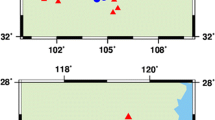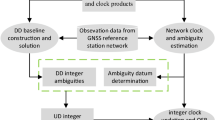Abstract
Rapid initialization is always challenging for precise point positioning ambiguity resolution (PPP-AR), and the tightly coupled (TC) models for multi-GNSS processing are generally regarded as an effective method. However, observable-specific biases exist in the BeiDou Navigation Satellite System (BDS)-2/3 observations, including signal distortion biases in the receiver-end, wide-lane (WL) inter-system phase biases and code inter-system biases, which inhibits the fusing processing and cannot take full advantages of BDS-2 and BDS-3. We derive the relationship between these biases and form an improved TC model to enable inter-BDS-2/BDS-3 PPP-AR on this basis. Based on 15-day BDS-2/BDS-3 data sets, we analyze the characteristics of BDS-2/BDS-3 observable-specific biases and further find that the proposed model can effectively handle them. On the server side, we demonstrate that the improved TC model performs optimally by assessing the performance of phase bias estimation. The proportion of WL ambiguity residuals within ± 0.1 cycles can remain roughly 92% with improvements of 44% and 14-day WL phase bias STDs for BDS can be declined to 0.009 cycles with significant improvements of beyond 72%. Regarding PPP-AR on the user side, the improved TC model can significantly improve positioning performance relative to the loosely coupled model, especially for kinematic solutions. Convergence time in the east, north and up components decreases by 32%, 24% and 19%, and reaches around 18.1, 13.5 and 22.0 min, respectively, whereas positioning precision can have spectacular gains of 54%, 42% and 34%, and its RMS can be declined to 0.032, 0.019 and 0.047 m in kinematic solutions. All the results fully demonstrate the superiority of the improved TC model in BDS-2/BDS-3 PPP-AR. It can indeed contribute to the promotion and application of BDS in the future.















Similar content being viewed by others
References
Bierman G (1975) The treatment of bias in the square-root information filter/smoother. J Optim Theory Appl 16(1):165–178. https://doi.org/10.1007/bf00935630
Böhm J, Niell A, Tregoning P, Schuh H (2006) Global Mapping Function (GMF): a new empirical mapping function based on numerical weather model data. Geophys Res Lett. https://doi.org/10.1029/2005gl025546
Chen H, Liu X, Jiang W, Yuan P, Ju B, Chen Y (2021) Preliminary analysis and evaluation of BDS-2/BDS-3 precise point positioning. Adv Space Res 68(10):4113–4128. https://doi.org/10.1016/j.asr.2021.07.044
Collins P (2008) Isolating and estimating undifferenced GPS integer ambiguities. In: Proceedings of the 2008 national technical meeting of the institute of navigation, pp 720–732
Deng C, Qi S, Li Y, Wang Y, Zou X, Tang W, Guo C (2021) A comparative analysis of navigation signals in BDS-2 and BDS-3 using zero-baseline experiments. GPS Solut 25(4):1–12. https://doi.org/10.1007/s10291-021-01178-z
Deng C, Qi S, Tang W, Hui M, Zou X, Wang Y et al (2022) Model comparison and performance analysis of multi-frequency precise positioning with the joint BDS-2 and BDS-3 system. Adv Space Res 69(8):3044–3058. https://doi.org/10.1016/j.asr.2022.01.039
Dong DN, Bock Y (1989) Global positioning system network analysis with phase ambiguity resolution applied to crustal deformation studies in California. J Geophys Res Solid Earth 94(B4):3949–3966. https://doi.org/10.1029/jb094ib04p03949
Fincke U, Pohst M (1985) Improved methods for calculating vectors of short length in a lattice, including a complexity analysis. Math Comput 44(170):463–471
Gabor MJ, Nerem RS (1999) GPS carrier phase ambiguity resolution using satellite-satellite single differences. In: Proceedings of the 12th international technical meeting of the satellite division of the institute of navigation (ION GPS 1999), pp 1569–1578
Gao W, Meng X, Gao C, Pan S, Wang D (2018) Combined GPS and BDS for single-frequency continuous RTK positioning through real-time estimation of differential inter-system biases. GPS Solut 22(1):1–13. https://doi.org/10.1007/s10291-017-0687-5
Ge M, Gendt G, Rothacher MA, Shi C, Liu J (2008) Resolution of GPS carrier-phase ambiguities in precise point positioning (PPP) with daily observations. J Geod 82(7):389–399. https://doi.org/10.1007/s00190-007-0208-3
Geng J, Shi C (2017) Rapid initialization of real-time PPP by resolving undifferenced GPS and GLONASS ambiguities simultaneously. J Geod 91(4):361–374. https://doi.org/10.1007/s00190-016-0969-7
Geng J, Li X, Zhao Q, Li G (2019) Inter-system PPP ambiguity resolution between GPS and BeiDou for rapid initialization. J Geodesy 93(3):383–398. https://doi.org/10.1007/s00190-018-1167-6
Gong X, Gu S, Lou Y, Zheng F, Ge M, Liu J (2018a) An efficient solution of real-time data processing for multi-GNSS network. J Geodesy 92(7):797–809. https://doi.org/10.1007/s00190-017-1095-x
Gong X, Lou Y, Zheng F, Gu S, Shi C, Liu J, Jing G (2018b) Evaluation and calibration of BeiDou receiver-related pseudorange biases. GPS Solut 22(4):1–10. https://doi.org/10.1007/s10291-018-0765-3
Gong X, Gu S, Zheng F, Wu Q, Liu S, Lou Y (2021) Improving GPS and Galileo precise data processing based on calibration of signal distortion biases. Measurement 174:108981
Hassibi A, Boyd S (1998) Integer parameter estimation in linear models with applications to GPS. IEEE Trans Signal Process 46(11):2938–2952
Hou P, Zhang B, Yuan Y, Zhang X, Zha J (2019) Stochastic modeling of BDS2/3 observations with application to RTD/RTK positioning. Meas Sci Technol 30(9):095002. https://doi.org/10.1088/1361-6501/ab1fad
Hou Y, Zhang Y, Chen J, Lian L, Wang J (2022) BDS-2/BDS-3 uncalibrated phase delay estimation considering the intra-system bias. Adv Space Res
Julien O, Alves P, Cannon ME, Zhang W (2003) A tightly coupled GPS/GALILEO combination for improved ambiguity resolution. In: Proceedings of the European navigation conference (ENC-GNSS’03), pp 1–14
Laurichesse D, Mercier F, Berthias JP, Bijac J (2008) Real time zero-difference ambiguities fixing and absolute RTK. In: Proceedings of the 2008 national technical meeting of the institute of navigation, pp 747–755
Li P, Zhang X (2014) Integrating GPS and GLONASS to accelerate convergence and initialization times of precise point positioning. GPS Solut 18(3):461–471. https://doi.org/10.1007/s10291-013-0345-5
Liu L, Hsu HT, Zhu YZ, Ou JK (1999) A new approach to GPS ambiguity decorrelation. J Geod 73(9):478–490
Liu Y, Lou Y, Ye S, Zhang R, Song W, Zhang X, Li Q (2017a) Assessment of PPP integer ambiguity resolution using GPS, GLONASS and BeiDou (IGSO, MEO) constellations. GPS Solut 21(4):1647–1659. https://doi.org/10.1007/s10291-017-0641-6
Liu Y, Ye S, Song W, Lou Y, Chen D (2017b) Integrating GPS and BDS to shorten the initialization time for ambiguity-fixed PPP. GPS Solut 21(2):333–343. https://doi.org/10.1007/s10291-016-0525-1
Liu Y, Ye S, Song W, Lou Y, Gu S (2017c) Rapid PPP ambiguity resolution using GPS+ GLONASS observations. J Geod 91(4):441–455. https://doi.org/10.1007/s00190-016-0975-9
Liu G, Guo F, Wang J, Du M, Qu L (2020) Triple-frequency GPS un-differenced and uncombined PPP ambiguity resolution using observable-specific satellite signal biases. Remote Sens 12(14):2310. https://doi.org/10.3390/rs12142310
Liu W, Wu M, Zhang X, Wang W, Ke W, Zhu Z (2021) Single-epoch RTK performance assessment of tightly combined BDS-2 and newly complete BDS-3. Satell Navig 2(1):1–17. https://doi.org/10.1186/s43020-021-00038-y
Lou Y, Gong X, Gu S, Zheng F, Feng Y (2017) Assessment of code bias variations of BDS triple-frequency signals and their impacts on ambiguity resolution for long baselines. GPS Solut 21(1):177–186. https://doi.org/10.1007/s10291-016-0514-4
Melbourne W (1985) The case for ranging in GPS-based geodetic systems. In: Proceedings of the first international symposium on precise positioning with GPS, pp 373–386
Odijk D, Teunissen PJ (2013) Characterization of between-receiver GPS-Galileo inter-system biases and their effect on mixed ambiguity resolution. GPS Solut 17(4):521–533. https://doi.org/10.1007/s10291-012-0298-0
Pan L, Xiaohong Z, Fei G (2017) Ambiguity resolved precise point positioning with GPS and BeiDou. J Geod 91(1):25–40. https://doi.org/10.1007/s00190-016-0935-4
Paziewski J, Wielgosz P (2017) Investigation of some selected strategies for multi-GNSS instantaneous RTK positioning. Adv Space Res 59(1):12–23. https://doi.org/10.1016/j.asr.2016.08.034
Paziewski J, Sieradzki R, Wielgosz P (2015) Selected properties of GPS and Galileo-IOV receiver intersystem biases in multi-GNSS data processing. Meas Sci Technol 26(9):095008. https://doi.org/10.1088/0957-0233/26/9/095008
Qu L, Du M, Wang J, Gao Y, Zhao Q, Zhang Q, Guo X (2019) Precise point positioning ambiguity resolution by integrating BDS-3e into BDS-2 and GPS. GPS Solut 23(3):1–11. https://doi.org/10.1007/s10291-019-0854-y
Rebischung P, Schmid R (2016) IGS14/igs14. atx: a new framework for the IGS products. In: AGU fall meeting 2016
Saastamoinen J (1972) Atmospheric correction for the troposphere and stratosphere in radio ranging satellites. Use Artif Satell Geod 15:247–251
Schnorr CP, Euchner M (1994) Lattice basis reduction: improved practical algorithms and solving subset sum problems. Math Program 66:181–199
Schönemann E, Becker M, Springer T (2011) A new approach for GNSS analysis in a multi-GNSS and multi-signal environment. J Geod Sci 1(3):204–214
Shi C, Hu Y, Zheng F, Zhang D (2022a) Accounting for BDS-2/BDS-3 inter-system biases in PPP and RTK models. Adv Space Res. https://doi.org/10.1016/j.asr.2022.05.030
Shi C, Tian Y, Zheng F, Hu Y (2022b) Accounting for signal distortion biases for wide-lane and narrow-lane phase bias estimation with inhomogeneous networks. Remote Sens 14(1):191. https://doi.org/10.3390/rs14010191
Temiissen JG (1995) The least-squares ambiguity decorrelation adjustment: a method for fast GPS integer ambiguity estimation. J Geod 70:65–82. https://doi.org/10.1007/bf00863419
Teunissen PJ (1999) An optimality property of the integer least-squares estimator. J Geod 73(11):587–593. https://doi.org/10.1007/s001900050269
Wubbena G (1985) Software developments for geodetic positioning with GPS using TI 4100 code and carrier measurements. In: Proceedings first international symposium on precise positioning with the global positioning system, pp 403–412. US Department of Commerce
Xu P (2001) Random simulation and GPS decorrelation. J Geod 75(7):408–423
Xu P, Shi C, Liu J (2012) Integer estimation methods for GPS ambiguity resolution: an applications oriented review and improvement. Surv Rev 44(324):59–71
Yao Y, Peng W, Xu C, Shi J, Cheng S, Ouyang C (2019) The realization and evaluation of mixed GPS/BDS PPP ambiguity resolution. J Geod 93(9):1283–1295. https://doi.org/10.1007/s00190-019-01245-x
Zhang X, Li P, Guo F (2013) Ambiguity resolution in precise point positioning with hourly data for global single receiver. Adv Space Res 51(1):153–161. https://doi.org/10.1016/j.asr.2012.08.008
Zhang Z, Li B, Nie L, Wei C, Jia S, Jiang S (2019) Initial assessment of BeiDou-3 global navigation satellite system: Signal quality, RTK and PPP. GPS Solut 23(4):1–12. https://doi.org/10.1007/s10291-019-0905-4
Zhang W, Cannon ME, Julien O, Alves P (2003) Investigation of combined GPS/GALILEO cascading ambiguity resolution schemes. In: Proceedings of the 16th international technical meeting of the satellite division of the institute of navigation (ION GPS/GNSS 2003), pp 2599–2610
Zhao W, Chen H, Gao Y, Jiang W, Liu X (2020) Evaluation of inter-system bias between BDS-2 and BDS-3 satellites and its impact on precise point positioning. Remote Sens 12(14):2185. https://doi.org/10.3390/rs12142185
Zheng F, Gong X, Lou Y, Gu S, Jing G, Shi C (2019) Calibration of BeiDou triple-frequency receiver-related pseudorange biases and their application in BDS precise positioning and ambiguity resolution. Sensors 19(16):3500. https://doi.org/10.3390/s19163500
Zhou Y (2011) A new practical approach to GNSS high-dimensional ambiguity decorrelation. GPS Solut 15(4):325–331
Zumberge JF, Heflin MB, Jefferson DC, Watkins MM, Webb FH (1997) Precise point positioning for the efficient and robust analysis of GPS data from large networks. J Geophys Res Solid Earth 102(B3):5005–5017. https://doi.org/10.1029/96jb03860
Acknowledgements
This study is supported by the National Nature Science Foundation of China (Grant Nos. 42004026 and 42227802) and Young Elite Scientists Sponsorship Program by CAST (YESS).
Author information
Authors and Affiliations
Contributions
FZ proposed the key idea; YT and FZ designed the research and wrote the paper; YT and XG developed the software and processed the data; DZ and CS were involved in writing, review and editing, and shared their discussions in the experiment related to the proposed methods.
Corresponding author
Ethics declarations
Conflict of interest
Authors have no conflict of interest to declare.
Rights and permissions
Springer Nature or its licensor (e.g. a society or other partner) holds exclusive rights to this article under a publishing agreement with the author(s) or other rightsholder(s); author self-archiving of the accepted manuscript version of this article is solely governed by the terms of such publishing agreement and applicable law.
About this article
Cite this article
Tian, Y., Zheng, F., Gong, X. et al. An improved tightly coupled model for precise point positioning ambiguity resolution with the Joint BDS-2 and BDS-3. J Geod 97, 42 (2023). https://doi.org/10.1007/s00190-023-01729-x
Received:
Accepted:
Published:
DOI: https://doi.org/10.1007/s00190-023-01729-x




